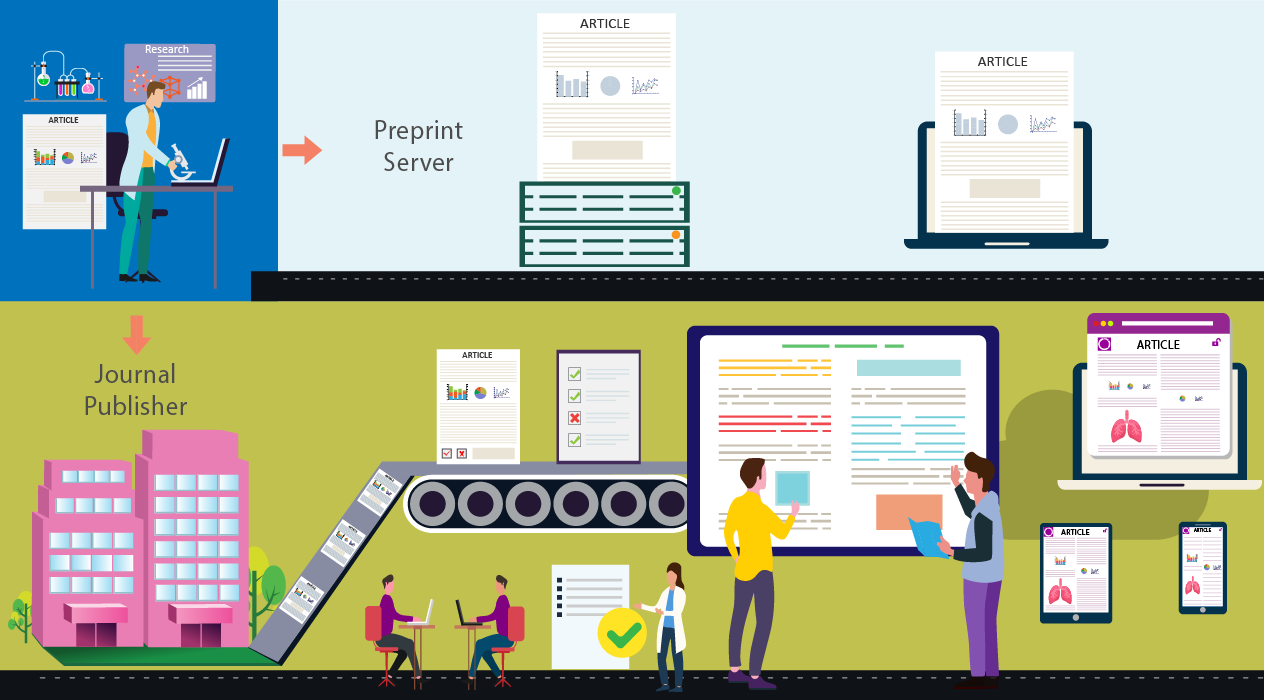Preprints in biomedical sciences are reshaping scientific communication due to the benefit of early release associated with it. However, it becomes equally essential to screen studies more stringently to avoid unverified publishing.
Key Areas: Science I Publishing I Open Access I Peer Review
Series: Publishing – News & Analysis

WHAT ARE PREPRINTS?
The Committee on Publication Ethics (COPE) defines preprints as scholarly manuscripts that are shared by the authors on openly accessible platform, usually before or in parallel with the peer review process [1]. Although preprints could be lightly edited and screened to prevent sharing of any inappropriate content, as they have not undergone standard peer review process [1-5].
A significant surge has been observed in COVID-19 related preprints during current pandemic, which helped in quick and easy sharing of scientific results among researchers [6]. However, this may also allow the release of unverified science, as these preprint articles are not regulated through peer review process. With a thorough understanding of benefits and limitations of preprints, authors can decide when it is appropriate to post the manuscript publicly on a preprint server. Likewise, researchers can make informed decision when basing their research on these preprints. In this article, we would explore rise of preprints, its benefits, concerns, and steps to minimize the disadvantages associated with it.
DEVELOPMENT OF PREPRINT SERVERS
Preprint archive was started in 1991 by Dr. Paul Ginsparg in Los Alamos National Laboratory (LANL) for articles in high energy physics [7]. Later in 2001, Dr. Ginsparg moved to Cornell University and changed the project name to arXiv (pronounced as archive) and now it hosts more than 1.8 million scientific preprints and receives over 15,000 new submissions every month, with most preprints in physical sciences and mathematics [8]. arXiv expanded its preprint support further in later years and launched arXiv q-biology server in 2003, which is dedicated solely to life science articles [9]. However, because of more regulated peer review process in life sciences, only 4,249 preprints were submitted in 2020 in arXiv q-biology server [10]. Cold Spring Harbor Laboratory (CSHL) launched bioRxiv server (pronounced as bio archive) in 2013 and later along with Yale University and BMJ Publisher launched medRxiv (pronounced as med archive) in 2019, which are becoming preferred preprint servers for life scientists and clinicians [11,12]. In June 2020, Chan Zuckerberg Initiative (CZI) announced $2 million funding support for medRxiv to drive awareness, support staff, and build infrastructure to enhance preprint services [13].
Despite the initial mixed responses to servers like bioRxiv and medRxiv, preprints are observing more growth in recent years [14,15]. Crossref which provides Digital Object Identifier (DOI) for citations have started providing DOI for preprints that helps in easy identification and citation of content [16]. In 2017, NIH and some other funders have also started accepting citations of the preprints in the research proposals [17,18]. Therefore, scientists are submitting more preprints now, and fields like neuroscience are observing notable growth [19]. However, despite the growth preprints are still not getting readily accepted in all fields of life sciences and only 1.3% of biology papers first appear as preprints [20].
BENEFITS OF PREPRINTS
Open Access
Preprints come under the umbrella of self-archiving and open access, which refers to availability of scholarly articles on digital platform without any pay-to-read barriers. Open access is endorsed by various funders and supported by open access mandates [21].
Visibility
According to research published in JAMA in 2018, articles which were posted on preprint servers have edge over the articles without preprints in citations and Altmetric score [22]. However, the correlation needs further research as there are contradictory reports that people still cite the preprints despite availability of published peer-reviewed article in the public domain [23].
No Delays
Authors prefer to share their research in preprints, in concurrent to preparing for publication in standard peer-reviewed journals, as preprints allow them to publicize their research with no delay. Publishing process in traditional journals may take a few months as peer review process, revisions and production require coordination between journal staff, handling editor, peer-reviewers, and authors to evaluate the manuscript in depth, revise and prepare it for a formal publication. Also, manuscript may undergo multiple rounds of reviews and revisions which increase overall time spent from submission to publication of a manuscript [24, 25]. Moreover, some publishers may take unnecessary long time, which could take up to 9 months [26].
Credit
Few journal publishers, NIH and other funding bodies have started allowing citation of preprints in manuscripts and grant applications [17,18,27]. Therefore, author and researchers are able to cite preprints in their publications and grant applications. Increasing acceptance and credibility of preprints also protects author’s work from research scooping, which was previously one concern in preprint publishing.
Feedback
Preprint offers the author an opportunity to receive feedback from peers. Author can utilize these feedbacks to improve their manuscript prior to a formal submission in a peer-reviewed journal.
Collaboration
Preprints may open new opportunities for research collaboration between authors and readers. Patient advocacy groups can also scour researchers working in specific disease areas and build partnerships to solve challenges faced by patients and healthcare providers.
Copyright
Majority of preprint servers allow open access publication of articles using Creative Commons licenses [28]. Creative Commons licenses provide credit to authors and make it easier for readers to download, distribute, and reuse the preprint as long as preprint is cited appropriately.
CONCERNS
Citation of Non Peer-Reviewed Content
Preprint servers provide cautionary note that preprints are non peer-reviewed preliminary reports that may contain errors and it should not be used in news media as established information [2-4].
Researchers should check preprints carefully before using it in their own research and publication. NIH recommends specific format for citing preprints in peer-reviewed article, such that readers can clearly identify that article is a preprint [17].
Once a manuscript is published in a peer-reviewed journal, preprint server add link for that peer-reviewed article. However, preprints are not removed from the preprint servers [29]. Thus, preprint can keep appearing on internet search engines that may create confusion among readers and may lead to loss of citation for the peer-reviewed published article [23]. Ideally, full text of preprint should be removed from the preprint server once article is published in a peer-reviewed journal. Also, this process should be automated.
Citation practices vary according to the field of research, for example, it is common in physics to cite the preprint article and they are judged as the published version. However, in biomedical sciences, it is more appropriate to cite the article which is published in a peer-reviewed journal.
Publication of Controversial Results
Once published on preprint servers, preprints may not be completely removed [29]. The articles could be marked “Withdrawn” if provided sufficient reasons, but it would remain on the server unless removed by the server themselves in cases of serious flaws, copyright issues, and author misconduct [29]. As preprints are not peer-reviewed and only checked for plagiarism and pseudoscience, there are more chances for controversial research to percolate into mainstream literature than through peer-reviewed journals. The preprint of a controversial COVID-19 related study, which is also one of the “most downloaded preprint article of all time” (with more than 1.5 million downloads from bioRxiv), is such an example [30,31]. This article was withdrawn quickly by vigilant authors once alerted through readers’ comments on inaccuracies in methodology and conclusion of the study. However, previous version of preprint is still available on preprint server, which can be downloaded and used by inattentive readers.
Rush to Print
In a rush to publish their results as soon as possible, scientists may submit incomplete or unverified results on preprint servers. Considering further impact of the article, author should assure the accuracy and reproducibility of the research before submitting it on preprint servers. An unbiased internal review by author’s colleagues could enhance the accuracy of the paper. Another reason to abstain from rushing is accidental loss of intellectual property, especially in case of patentable research work. Authors should consult their institute’s technology transfer office before submitting any high-stake results at preprint servers.
Some Journals may not support Preprints
Preprints generally do not cause any copyright-related conflict with fully open access peer-reviewed journals. However, some subscription-based publishers do not clarify if they support preprint posting of articles prior to submission of article to their journals [27]. Before submitting any manuscript at preprint server, author should verify that the journal (where they plan to submit their article) allows preprint publication and does not require any copyright transfer at a later stage of publication.
Lack of Comments and Non-Constructive Criticism
One of the major reason authors prefer preprints is feedback of their peer scientists; but only about 10% of bioRxiv articles have interactions such as public comments on articles [32]. However, as more and more researchers start using preprints, public engagement is anticipated to increase.
Identity Disclosure
Preprints publish name and affiliation of authors along with the content. Public revelation of name and affiliations of authors in preprints weakens double-blinded peer review process of many peer-reviewed journals. Study published in JAMA indicates that when peer review process is blinded, inadvertent bias related to reputation and location of author is reduced during evaluation of manuscripts by peer-reviewers [33]. Thus, identity disclosure prior to completion of peer review may hurt the overall peer review process.
CONCLUSION
Preprint is a great tool for authors to disseminate science immediately and receive feedback from peers to improve their research. However, readers should understand that preprints are not formally peer-reviewed, and it should be used carefully.
Peer review is the quintessential checkpoint for the verification of scientific articles, especially in biomedical sciences. Preprints should be used for early sharing of research output instead of replacing the need of peer-reviewed publication in scientific journals.
Qualiten Journals do not consider preprints as duplicate submissions and accept submission of manuscripts which are already submitted by author at preprint servers. Public comments received at preprint server may complement the formal comments received by authors during our peer review process, thereby supporting author in manuscript revision. Best science is possible through cooperation and continuous refinement; authors, preprint servers and peer-reviewed journals can work together to make scientific communication more productive, efficient and reliable.
If you liked this article, you may share it with your peers and can subscribe alerts to get notified about our future content. You may send us your feedback and comments for improvement at staff@qualiteninsight.com.
“Best science is possible through cooperation and continuous refinement; authors, preprint servers and peer-reviewed journals can work together to make scientific communication more productive, efficient and reliable.”
– Qualiten Press
Copyright © 2021 Qualiten Press














